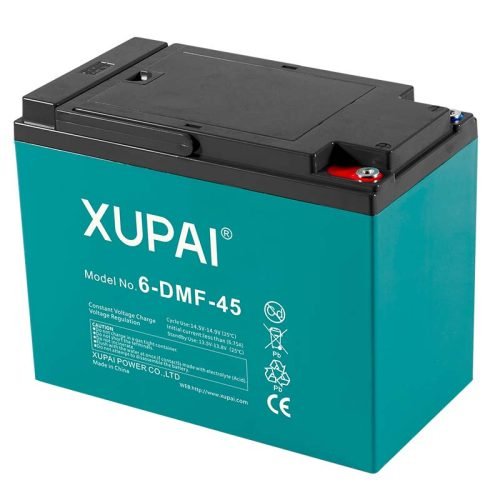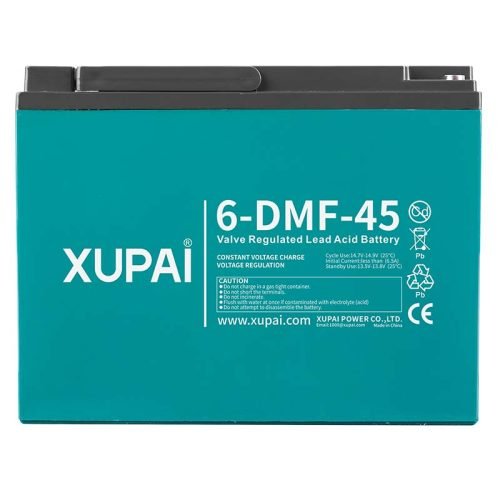The 12V45Ah deep-cycle lead-acid battery is engineered for performance and reliability across multiple applications—mobility scooters, electric trikes, e-rickshaws, floor scrubbers, and other light EV or industrial machines. Built with a robust ABS casing, copper terminals, and excellent deep-cycle capability, it provides stable output even in demanding conditions. For businesses, it offers consistent quality, long service life, and excellent cost-effectiveness—ideal for fleet operators and distributors. For consumers, it’s safe, easy to use, and ready for daily convenience. From cold mornings to hot afternoons, this battery ensures dependable energy whenever you need it.


| Parameters | Specification |
|---|---|
| Voltage (V) | 12 |
| 3hr Capacity (Ah) | 45 |
| Dimensions (±2mm) (L×W×H×T/H) | 223 × 120 × 175 × 175 mm |
| Weight (Kg) | 13.00 ± 0.1 |
| Material of Shell | ABS |
| Max Resistance (mΩ) | <11 |
| Terminal | Copper |
| Operating Temperature Range | Discharge: -35°C ~ 50°C Charge: -15°C ~ 40°C Storage: -15°C ~ 40°C |
| Capacity ≥ (Ah, 25°C) | 3hr (15.0A to 10.5V): 45 5hr (9.0A to 10.5V): 47.5 10hr (4.50A to 10.5V): 49.5 20hr (2.25A to 10.5V): 52.5 |
| Self-Discharge Rate (20°C) | >85% / 3 months |
| Charging Voltage (V) | Floating: 13.5V ~ 13.8V Cycling: 14.4V ~ 14.8V |
| Discharge Current (A) | 4.5 I3 |
| Charge Current (A) | 0.15 C3 |
| Terminal Size | φ11.8 – M5 |
| Residual Capacity After Self-Discharge | 30d: 90% 60d: 85% 90d: 82% 180d: 80% |
| Time Rate | Current (A) to 10.5V | Capacity (Ah) |
|---|---|---|
| 3 hr | 15.0 A | 45 Ah |
| 5 hr | 9.0 A | 47.5 Ah |
| 10 hr | 4.50 A | 49.5 Ah |
| 20 hr | 2.25 A | 52.5 Ah |
| Region | Brand | Model | Equipment Type |
|---|---|---|---|
| Europe | Pride Mobility | Colt Deluxe (SC710DX) | Mobility Scooter |
| Europe | Shoprider | Cadiz (S-889SL) | Mobility Scooter |
| Europe | TGA Mobility | Breeze S4 | Mobility Scooter |
| Europe | Freerider | City Ranger 8 | Mobility Scooter |
| Europe | Hako | Scrubmaster B30 | Walk-Behind Scrubber-Drier |
| Europe | Nilfisk | SC351 | Micro Scrubber |
| Europe | Tennant | T1B | Micro Scrubber |
| Americas | Sunmax | RT15 | Floor Scrubber |
| Americas | Emotor | EM-25 | Floor Scrubber |
| Americas | Crystal | C16 | Floor Scrubber |
| Americas | CleanFreak | EasySweep | Vacuum Sweeper |
| Americas | Teledyne ISCO | 3700 | Portable Water Sampler |
| Americas | Tennant | T1 | Micro Scrubber |
| Southeast Asia | EVT (Taiwan) | 168 | Electric Scooter |
| Southeast Asia | Bravo | EVT-345 | Electric Scooter |
| Southeast Asia | Motrike (JOBO) | Recumbent Trike Tuk Tuk | Electric Tricycle |
| Southeast Asia | 7Plus (Xiamen) | KH01 | Electric Rickshaw/Tricycle |
| Southeast Asia | XYP | 3-Door Dumper Tricycle | Electric Tricycle |
| Southeast Asia | Yuejiang | Long-Range E-Scooter | Electric Motorcycle/Scooter |
| Americas | CleanFreak | EasySweep (Battery Pack) | 12V 45Ah Battery Application |
Charge Regularly, Don’t Wait Too Long
Avoid letting your battery sit empty for long periods. Try to recharge it after every use, even if it’s only partially discharged. A healthy battery is a charged battery!
Avoid Deep Discharges Too Often
While the battery can handle deep cycles, it’s best not to drain it completely every time. Keeping the charge above 30–40% helps extend its lifespan.
Use the Right Charger
Always pair your battery with a compatible smart charger. A charger with automatic cut-off and pulse repair function can prevent overcharging and keep the cells healthy.
Keep It Cool (But Not Too Cold!)
Extreme heat shortens battery life, and freezing conditions reduce performance. Store and use the battery in moderate temperatures whenever possible.
Clean the Terminals
Check the copper terminals regularly and keep them free of dust and corrosion. A simple wipe with a dry cloth can improve connection and efficiency.
Secure It Properly
Make sure the battery is tightly fixed in place. Excessive vibration from vehicles or machines can damage the internal plates over time.
Top Up with a Refresh Charge
If the battery isn’t used often, give it a full charge every month. This prevents self-discharge and keeps the cells active.
Don’t Overload It
Follow the recommended discharge current. Running equipment that demands more than the rated output can strain the battery and shorten its life.
Watch for Warning Signs
If you notice reduced run time, slower charging, or swelling, it’s time to check the health of the battery or replace it.
Plan for Seasonal Care
In colder months, charge indoors if possible. In hot weather, avoid leaving the battery in direct sunlight during charging or storage.
Pick a Well-Ventilated, Stable Location
Choose a cool, dry, and well-ventilated spot—away from heat sources and direct sunlight. Ensure it’s a sturdy, level surface to support the battery’s weight safely.
Use Proper Protection
Always wear insulated gloves and safety glasses when handling the battery.
Inspect Carefully Before Setup
Check that there is no visible damage, cracks, or terminal corrosion. Clean the terminals and tray if needed before proceeding.
Mount Solidly, Minimize Movement
Secure the battery using appropriate brackets or racks. If used in mobile equipment, include padding to reduce vibration.
Leave Some Air Space Around
Provide clearance between batteries for airflow and heat dissipation.
Correct Cable Choice & Proper Termination
Use stranded copper cables rated for the correct current. Keep positive and negative cables clear.
Polarity & Fusing
Connect positive (+) to positive, and negative (–) to negative. Install a fuse or disconnect near the battery.
Torque Securely, Inspect Periodically
Tighten terminal connections firmly, and re-check periodically to prevent resistance and heat buildup.
Follow a 3-Stage Charging Method
Use the “bulk → topping → float” charging cycle to ensure full capacity and avoid sulfation.
Use Correct Charger Settings
Set your charger to 12 V and the correct battery type (AGM/Flooded/Sealed).
Charge in Good Conditions
Charge in a well-ventilated, moderate–temperature area to avoid overheating.
Don’t Store in a Discharged State
Always fully charge before storage to prevent sulfation.
Routine Checks for Fluids (If Flooded Type)
Check electrolyte levels regularly and top up with distilled water if needed.
Watch for Corrosion & Clean as Needed
Keep terminals clean and apply protective grease to reduce corrosion.
Manage Heat Exposure
Avoid placing the battery in direct heat or freezing environments.
If Battery Swells or Vents Gas—Replace It
Swelling or venting is a sign of damage, and the battery should be replaced immediately.
Follow Local Regulations for Recycling
Always dispose of old or damaged batteries at approved recycling centers. Never incinerate.
12‑month limited warranty against manufacturing defects. Technical support available for installation and charging best practices.
Reliable Energy for Scooters, Trikes & Cleaning Machines
One year from the date of shipment



Tell us your application, voltage/capacity, target quantity, and delivery terms. Our team will reply within 24 hours.